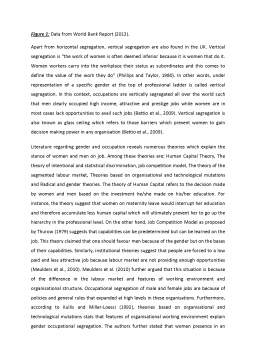Extras din referat
A critical evaluation of:
“Despite increasing effort to lift barriers to men and women’s participation in jobs deemed to be suitable for the ‘other’, with the introduction of new job roles in each domain for example, gender stratification by occupation still persists as professions are frequently categorized by society as suitable for one gender or another.”
“Occupations are gendered” is a well-known fact in the gender literature now a days. According to Blackburn and Jarman (2006), gender stratification in professions is absorb almost in every country, particularly the level of gender stratification is very high in the most industrialised economies such as USA, Europe, and Japan etc. In fact, men and women participation in different jobs are disproportionately large in some areas. However, Cotter et al. (1997) argued that gender stratification in almost every profession can be absorbed and therefore, jobs are segregated according to society. In other words, jobs are divided into groups of men and women such as jobs like police, IT, constructions are designated as manly jobs while school teaching, nursing, and care taking are considered as womanly jobs. However, generally it has been argued by many researchers that in today’s modern society, men particularly hold better jobs with high pay and prestige and they find working in the women environment as problematic and less attractive because they are low paid jobs (Lupton, 2000). However, according to McDowell (2014), in today’s economic recession well-paid jobs are rare to find in the industry for men and that is why they are now targeting other jobs which are particularly considered as women jobs. For instance, according to NMC (2008), the number of male entering into women’s job such nursing is increased from 9.20 to 10.73 from year 2002 to 2007 in UK only.
According to Kelan (2010), gender is a cultural construct which result from the biological sex and place certain restrictions on how sex can be perform within a society. The Author further suggests that gender also frames the extent to which suitable roles are define for male and female. Masculine and Feminine behaviour are formed by gender separation such that male and female will behave in the society based on the appropriateness of these constructs for gender (Ku, 2011). This gender separation has a direct impact on the work roles seen appropriate for male and female, which further suggest that occupations can be categorised into group based on its appropriateness for men or women (McDowell, 2015). Gender segregation of professions are formed based on the skills and features that male and female are assumed to comprehend. In this context, work places for women are characterised by the characteristics of femininity (caring, supportive and person oriented) while characteristics of men working places are mainly associated masculinity (i.e. competitiveness, aggressiveness, and dominance) (Baxter, 2010; McDowell, 2015). This gender categorisation bear the idea that one gender group may not have the necessary skills sets to perform the job of other gender.
Gender is used as a main indicator of structuring the labour force. In this context, male work continuously till their retirement while female have more diverse ways of doing their jobs. Furthermore, as mentioned earlier male and female tends to work in specific occupation which give rise to occupational segregation (Reskin and Bielby, 2005). This occupational segregation give rise to gender inequalities particularly, when one gender (i.e. men) are working in highly paid and attractive sector while other (i.e. women) are working in low paid and part time. Furthermore, male and female are occupationally segregated in almost every part of the world to different degrees.
This gender segregation in professions remain the key characteristics of UK society which greatly affect both paid and unpaid women worker. As stated by Oakley (1982) “Women’s employment has tended to be concentrated in a small number of industries and confined to a range of jobs which might be described as women’s work”. In fact, in every society whether it is western or eastern, women always hold position that are less attractive and have low responsibilities, although they work alongside men. Apart from professional commitments, women also bear the responsibilities of taking care of the family (Fagan and Burchell, 2002). As a result, women are working in a profession with more reliable hours and part time with very low salary. Although, low salary is not because of part time working but because of gender pay gap that exists in all professions across different sector in UK (Green et al., 2008). Working part time is considered to be a flexible alternative for female that have various domestic duties, which suggests some kind of autonomy for working women (Deutsch, 2007). However, the author further suggests that there are some other structural barriers to working women which limit that autonomy such as childcare availability and start and finish times of schools. Women autonomy at work is also obstructed by her progression to high professional posts because of the traditional masculinist model prevail in most organisational at management level (Reskin and Bielby, 2005).
Preview document
Conținut arhivă zip
- A critical evaluation.docx


















